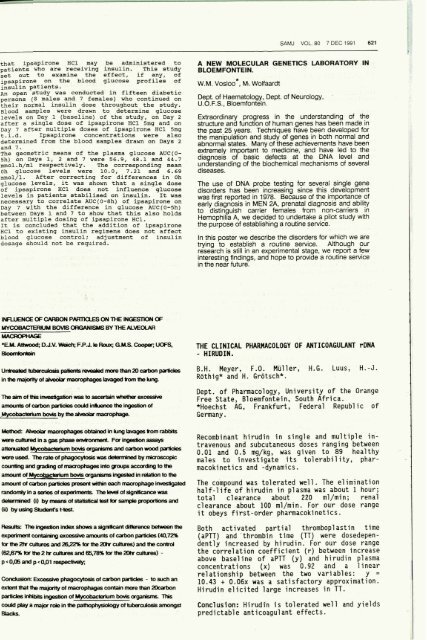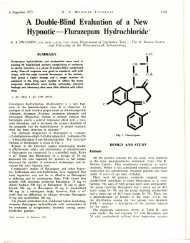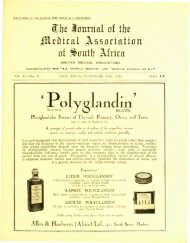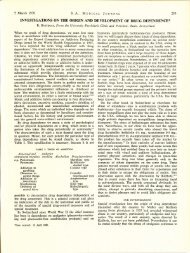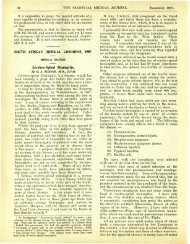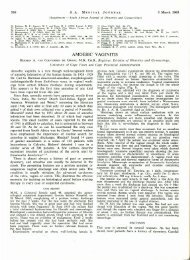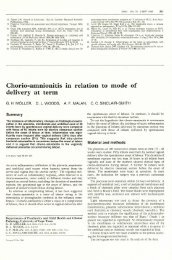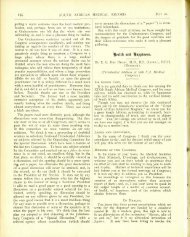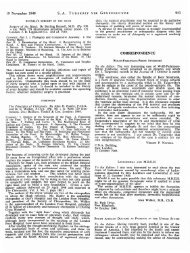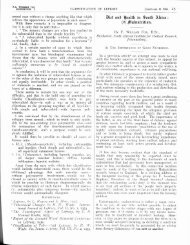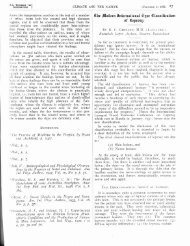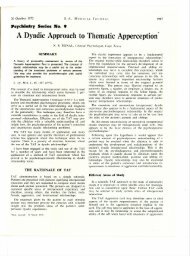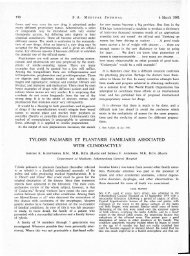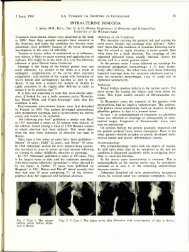Universiteit van die Oranje-Vrystaat - SAMJ Archive Browser
Universiteit van die Oranje-Vrystaat - SAMJ Archive Browser
Universiteit van die Oranje-Vrystaat - SAMJ Archive Browser
Create successful ePaper yourself
Turn your PDF publications into a flip-book with our unique Google optimized e-Paper software.
that ipsapirone HCl may be administered to<br />
who are receiving insulin. This study<br />
set out to examine the effect, if any, of<br />
ipsapirone on the blood glucose profiles of<br />
insulin patients.<br />
m open study was conducted in fifteen diabetic<br />
persons (8 males and 7 females) who continued on<br />
their normal insulin dose throughout the study.<br />
~lood samples were drawn to determine glucose<br />
levels on Day 1 (baseline) of the study, on Day 2<br />
after a single dose of ipsapirone HC1 5mg and on<br />
Day 7 after multiple doses of ipsapirone HC1 5mg<br />
t.i.d. Ipsapirone concentrations were also<br />
determined from the blood samples drawn on Days 2<br />
and 7.<br />
The geometric means of the plasma glucbse AUC(O-<br />
5h) on DBys 1, 2 and 7 were 56.9, 48.1 and 44.7<br />
mmol.h/ml respectively. The corresponding mean<br />
oh glucose levels were 10.0, 7.21 and 6.69<br />
mmol/l. After correcting for differences in Oh<br />
glucose levels, it was shown that a single dose<br />
of ipsaplrone HC1 does not influence glucose<br />
levels in patients stabilised on insulin. It was<br />
necessary to correlate AUC(0-8h) of ipsapirone on<br />
Day 7 with the difference in glucose AUC(0-5h)<br />
between Days 1 and 7 to show that this also holds<br />
after multiple dosing of ipsapirone HC1.<br />
It is concluded that the addition of ipsapirone<br />
HC1 to existing insulin regimens does not affect<br />
blood glucose control; adjustment of insulin<br />
dosage should not be required.<br />
ConcLsion: Excessive phagocytosis of carbon parCdes - to such an<br />
erdentlhatthemaprityofmacrophagescontainmoreIhanaOcarbon<br />
parfidea;inhibitsingestionof~~arganiwrslhis<br />
ewklpiayanrajorrdeinthepalhophysidogyof-amongst<br />
Blacks<br />
<strong>SAMJ</strong> VOL 80 7DEC 1991 621<br />
A NEW MOLECULAR GENETICS LABORATORY IN<br />
BLOEM FONTEBN.<br />
W.M. ~oslw*, W WoWdt<br />
Dept. of Haematology, Dept. of Neurology,<br />
U.O.F.S., Bloemfontein.<br />
Extraordinary props in the understanding of the<br />
structure and funmon of human genes has been made in<br />
the past 25 years. Techniques have been developed for<br />
the manipulation and study of genes in both normal and<br />
abnormal states. Many of these achievements have been<br />
extremely importaqt to medicine, and have led to the<br />
osis of base defects at the DNA hel and<br />
un erstanding of the bimical mechanisms af several<br />
diseases.<br />
The use of DNA probe testing for several single gene<br />
disorders has been increasing since this development<br />
was first reported in 1978. Because of the importance of<br />
early diagnosis in MEN 24 prenatal diagnosis and ability<br />
to distinguish carrier females from non-carriers In<br />
Hemophilia A, we decided to undertake a p~lot study with<br />
the purpose of establishing a routine service.<br />
In this poster we describe the disorders for which we are<br />
trying to establish a routine service. Although our<br />
research is still in an experimental stage, we report a few<br />
interesting findings, and hope to provide a routine service<br />
in the near future. . % J - ~ ~<br />
, , -<br />
ME CLINICAL PHARMACOLOGY OF ANTICOAGULANT rDNA<br />
- HIRUDIN.<br />
B.H. Meyer, F.O. Muller, H.G. Luus, H.-J.<br />
Rothig* and H. Grotsch*.<br />
Dept. of Pharmacology, University of the Orange<br />
Free State, Bloemfontein, South Africa.<br />
*Hoechst AG, Frankfurt, Federal Republic of<br />
Germany.<br />
Recombinant hirudin in single and multiple in-<br />
travenous and subcutaneous doses ranging between<br />
0.01 and 0.5 mg/kg, was given to 89 healthy -<br />
males to investigate its tolerability, phar-<br />
macokinetics and -dynamics.<br />
The compound was tolerated we1 l . The el imination<br />
half-life of hirudin in plasma was about 1 hour;<br />
total clearance about 220 ml/min; renal<br />
clearance about 100 ml/min. For our dose range<br />
it obeys first-order pharmacokinetics.<br />
Both activated partial thromboplastin time<br />
(aPTT) and 'thrombin time (TT) were dosedepen-<br />
dently increased by hirudin. For our dose range<br />
the correlation coefficient (r) between increase<br />
above base1 ine of aPl7 (y) and hirudin plasma<br />
concentrations (X) was 0.92 and a l inear<br />
relationship between the two variables: y =<br />
10.43 + 0.06~ was a satisfactory approximation.<br />
Hirudin elicited large increases in TT.<br />
Conclusion: Hirudfn is tolerated well and yields<br />
predictable anticoagulant effects.


